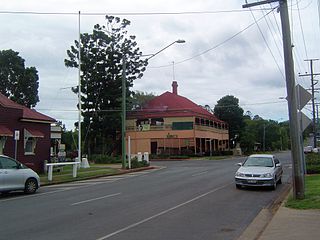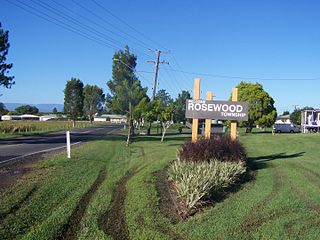
Ipswich is a city in South East Queensland, Australia. Situated on the Bremer River, it is approximately 40 kilometres (25 mi) west of the Brisbane central business district. The city is renowned for its architectural, natural and cultural heritage. Ipswich preserves and operates from many of its historical buildings, with more than 6000 heritage-listed sites and over 500 parks. Ipswich was founded in 1827 as a mining settlement. The suburb of the same name is its central business district.

Llwynypia is a village and community in Rhondda Cynon Taf, Wales, near Tonypandy in the Rhondda Fawr Valley. Before 1850 a lightly populated rural farming area, Llwynypia experienced a population boom between 1860 and 1920 with the sinking of several coal mines after the discovery of large coal deposits throughout the Rhondda Valleys.

Marburg is a rural town in the City of Ipswich and a locality split between the City of Ipswich and the Somerset Region, both in Queensland, Australia. In the 2016 census, the town had a population of 873 people.

Ipswich Knights Football Club is an Australian soccer club from Ipswich, Queensland. The Ipswich Knights were formed in 1998 and was an amalgamation of two Ipswich clubs, the Bundamba-based "Coalstars" and the Ebbw Vale-based "St Helens United". Ipswich Knights currently play in the Football Queensland Premier League 2.

Rosewood is a rural town and locality in the City of Ipswich, Queensland, Australia. In the 2016 census, the locality of Rosewood had a population of 2,834 people.

The Shire of Laidley was a local government area located in the Lockyer Valley region between the cities of Toowoomba and Ipswich, and about 70 kilometres (43 mi) west of Brisbane, the state capital of Queensland, Australia. The shire covered an area of 700.6 square kilometres (270.5 sq mi), and existed from 1888 until its merger with the Shire of Gatton to form the Lockyer Valley Region on 15 March 2008.

Amberley is a suburb in the City of Ipswich, Queensland, Australia. In the 2016 census, Amberley had a population of 253 people.

Tivoli is a suburb in the City of Ipswich, Queensland, Australia. In the 2016 census, Tivoli had a population of 1,487 people.

Dinmore is a suburb of Ipswich in the City of Ipswich, Queensland, Australia. In the 2016 census, Dinmore had a population of 875 people with an unemployment rate of 16.7%, in comparison to the Australian unemployment rate of 6.9%.

Ebenezer is a rural locality in the City of Ipswich, Queensland, Australia. In the 2016 census, Ebenezer had a population of 315 people.
The Queensland Times is an online newspaper serving Ipswich and surrounds in Queensland, Australia. The newspaper is owned by News Corp Australia. The circulation of The Queensland Times is 10,804 Monday to Friday and 14,153 on Saturday.

The Shire of Rosewood is a former local government area in the south-east of Queensland, Australia.

The Shire of Mutdapilly is a former local government area in the south-east of Queensland, Australia. The name comes from the Mutdapilly locality, but the locality was never the administrative centre of the shire.

The Main Line is a railway line in South East Queensland, Australia. It was opened in a series of sections between 1865 and 1867. It commences at Roma St Station in Brisbane and extends west 161 km to Toowoomba. It is the first narrow gauge main line constructed in the world. The section of the line from the end of Murphys Creek railway station to the Ruthven Street overbridge, Harlaxton is listed on the Queensland Heritage Register. The Murphys Creek Railway Complex, the Lockyer Creek Railway Bridge (Lockyer), the Lockyer Creek Railway Bridge and Swansons Rail Bridge are also heritage listed.

Blair Athol is a former town within Clermont in the Isaac Region, Queensland, Australia. It was obliterated by the development of the Blair Athol coal mine.

Rockton is a heritage-listed villa at Rockton Street, Newtown, City of Ipswich, Queensland, Australia. It was built from 1855 onwards. It was added to the Queensland Heritage Register on 21 October 1992.

Lanefield is a rural locality in the City of Ipswich, Queensland, Australia. In the 2016 census, Lanefield had a population of 107 people.
Ray Whitmore (1920–2008) was a British mining and metallurgical engineer and academic, who specialised in research into radar, mining and metallurgical engineering and mining heritage in England and Australia.
Helen Haenke (1916–1978) was an Australian artist, poet and playwright whose work was part of an emerging literary community in south-east Queensland in the late 1960s and 1970s.


















